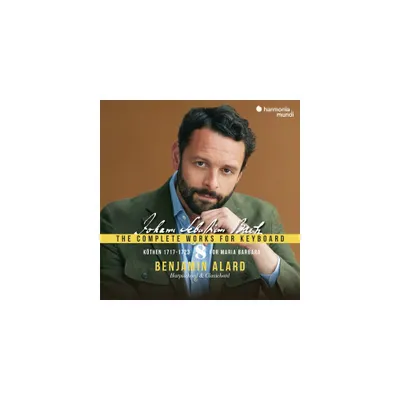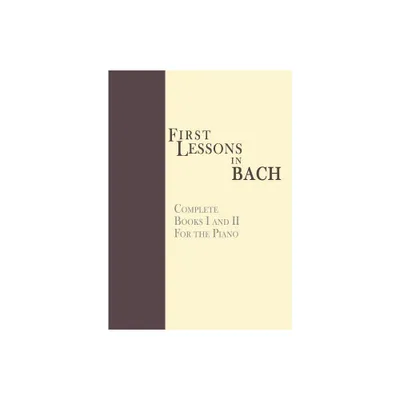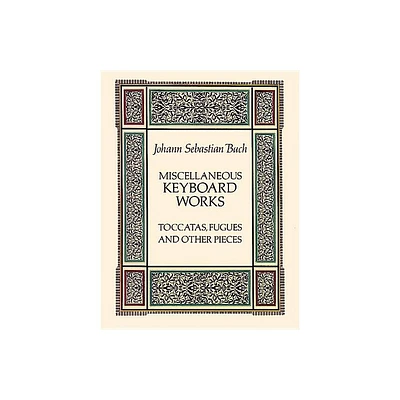Home
Johann Sebastian Bach: The Complete Works for Keyboard, Vol. 8 - Köthen 1717-1723 for Maria Barbara
Loading Inventory...
Barnes and Noble
Johann Sebastian Bach: The Complete Works for Keyboard, Vol. 8 - Köthen 1717-1723 for Maria Barbara
Current price: $31.99


Barnes and Noble
Johann Sebastian Bach: The Complete Works for Keyboard, Vol. 8 - Köthen 1717-1723 for Maria Barbara
Current price: $31.99
Loading Inventory...
Size: OS
*Product Information may vary - to confirm product availability, pricing, and additional information please contact Barnes and Noble
Benjamin Alard
's complete cycle of
Bach
's keyboard music is doubly radical. First, there are the ambitious dimensions of the project, something that nobody has attempted before. Second, each individual release tends to offer extremely unorthodox decisions regarding forces and interpretation. This
eighth volume
is typical. The theme is indicated by the subtitle,
For Maria Barbara
; the music here is from
's Koethen period and was more or less closely connected to
's first wife -- the sonatas and partitas for solo violin may have been a kind of memorial for her. These have been transcribed for keyboard instruments before, a questionable decision in that they depend musically on the difficulty of adapting polyphony to a solo violin, but
Alard
goes further than anyone else, performing the
Sonata in D minor, BVW 964
, and the big Chaconne from the
Partita No. 2 for solo violin, BWV 1004
, on a pedal clavichord.
is absolutely right to note that the clavichord remains unrecognized as a common household instrument in
's time and far beyond; the pedal variant was developed to let organists practice at home. It was a quiet instrument, and this is not good enough for
, who decides to amplify it greatly. The effect of this, picking up a great deal of ambient noise, is unusual enough that listeners are going to have to make up their own minds about it; it is kind of like going to a rock concert. The second part of the program includes the
Inventions
and
Sinfonias
, BWV 772-801, otherwise known as
Two
- and
Three-Part
Inventions. The clavichord makes a good deal more sense in these. The program also features two of the
French Suites
, played on a 1645 harpsichord "ravaled" (this word is not even in most English dictionaries -- it is from French "ravalement," facelift, cleaning, restoration) by a later maker. These are stirring performances, and there is another unorthodox twist: pieces from
Couperin
's
L'art de toucher le clavecin
frame the suites. This actually works; the
were not so named until after
's death, but their models are French, and
could have been in
's head. As is becoming usual with
, listeners may not buy everything he does, but the album is an adventure, and one awaits the next with great interest. ~ James Manheim
's complete cycle of
Bach
's keyboard music is doubly radical. First, there are the ambitious dimensions of the project, something that nobody has attempted before. Second, each individual release tends to offer extremely unorthodox decisions regarding forces and interpretation. This
eighth volume
is typical. The theme is indicated by the subtitle,
For Maria Barbara
; the music here is from
's Koethen period and was more or less closely connected to
's first wife -- the sonatas and partitas for solo violin may have been a kind of memorial for her. These have been transcribed for keyboard instruments before, a questionable decision in that they depend musically on the difficulty of adapting polyphony to a solo violin, but
Alard
goes further than anyone else, performing the
Sonata in D minor, BVW 964
, and the big Chaconne from the
Partita No. 2 for solo violin, BWV 1004
, on a pedal clavichord.
is absolutely right to note that the clavichord remains unrecognized as a common household instrument in
's time and far beyond; the pedal variant was developed to let organists practice at home. It was a quiet instrument, and this is not good enough for
, who decides to amplify it greatly. The effect of this, picking up a great deal of ambient noise, is unusual enough that listeners are going to have to make up their own minds about it; it is kind of like going to a rock concert. The second part of the program includes the
Inventions
and
Sinfonias
, BWV 772-801, otherwise known as
Two
- and
Three-Part
Inventions. The clavichord makes a good deal more sense in these. The program also features two of the
French Suites
, played on a 1645 harpsichord "ravaled" (this word is not even in most English dictionaries -- it is from French "ravalement," facelift, cleaning, restoration) by a later maker. These are stirring performances, and there is another unorthodox twist: pieces from
Couperin
's
L'art de toucher le clavecin
frame the suites. This actually works; the
were not so named until after
's death, but their models are French, and
could have been in
's head. As is becoming usual with
, listeners may not buy everything he does, but the album is an adventure, and one awaits the next with great interest. ~ James Manheim


















